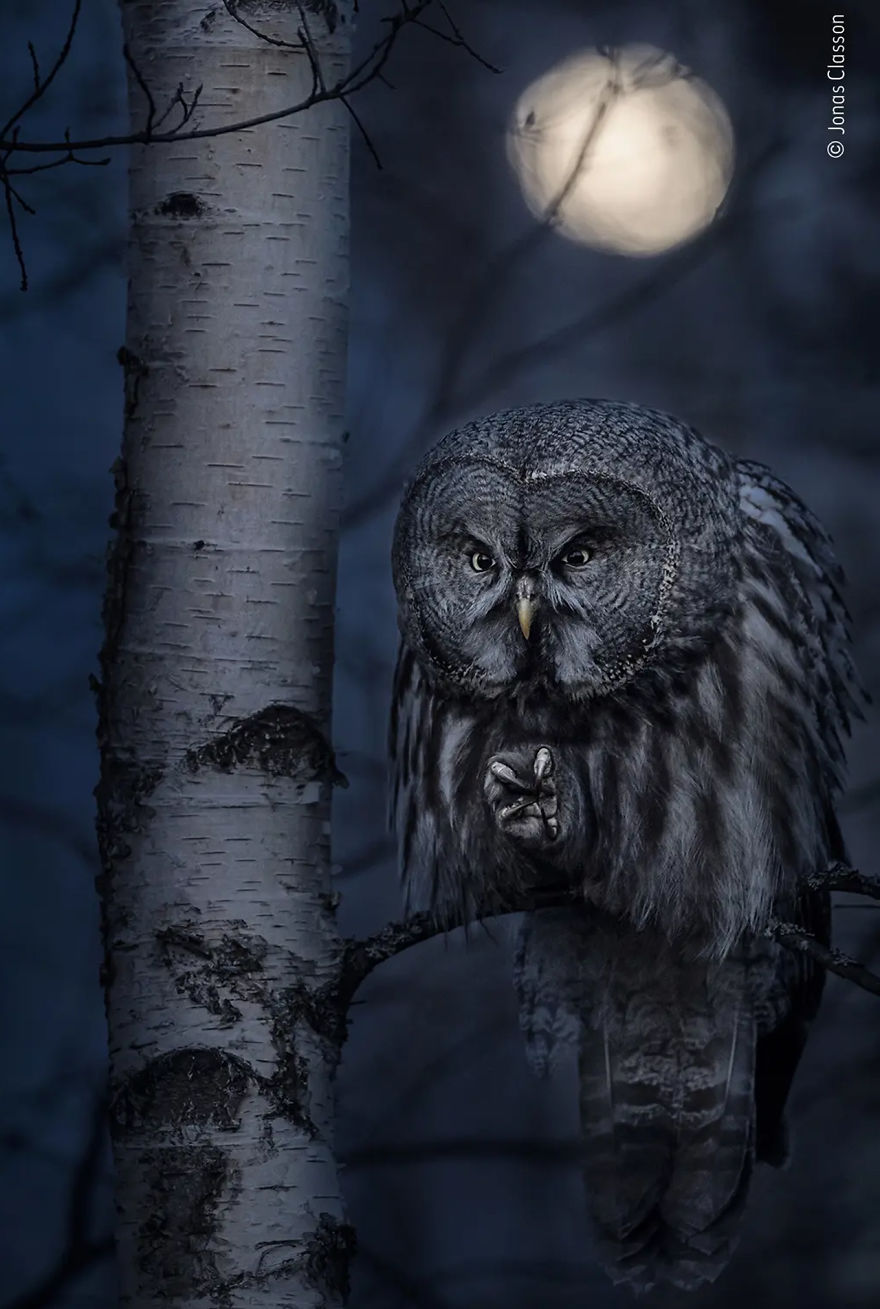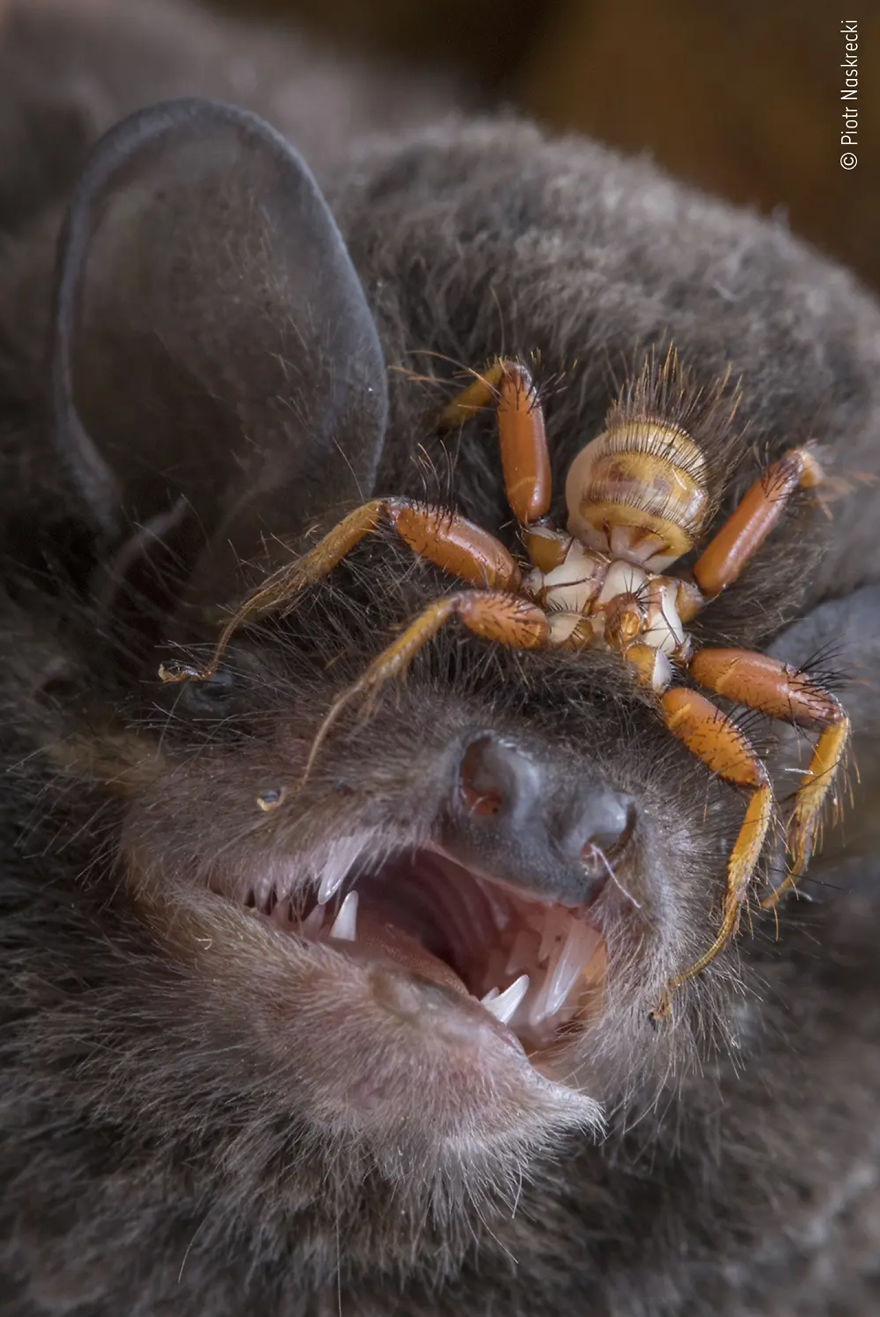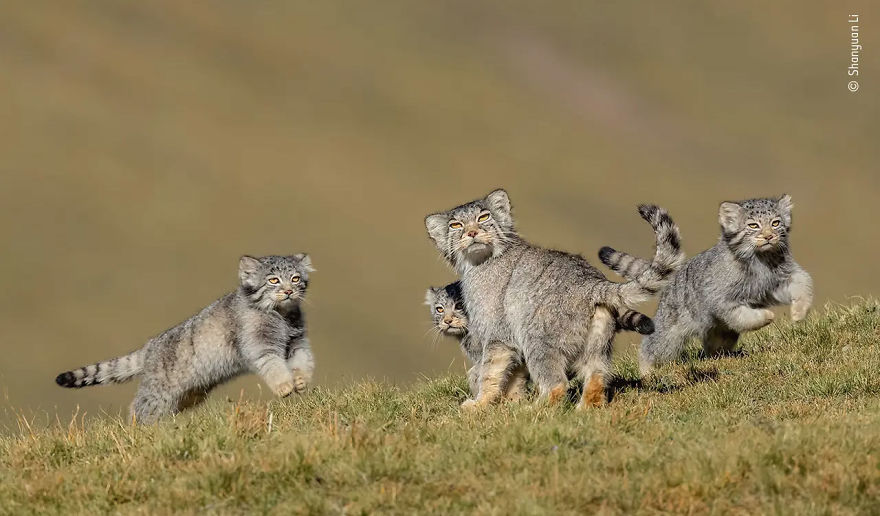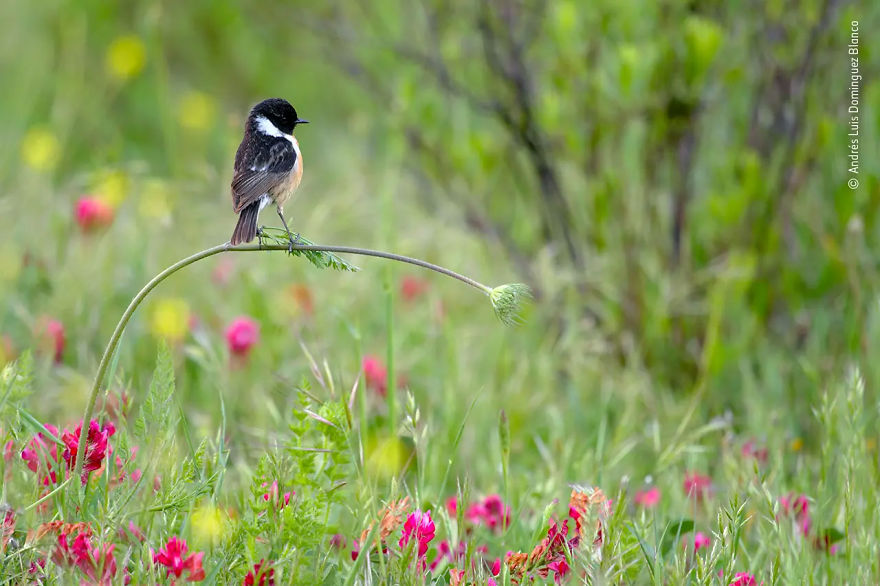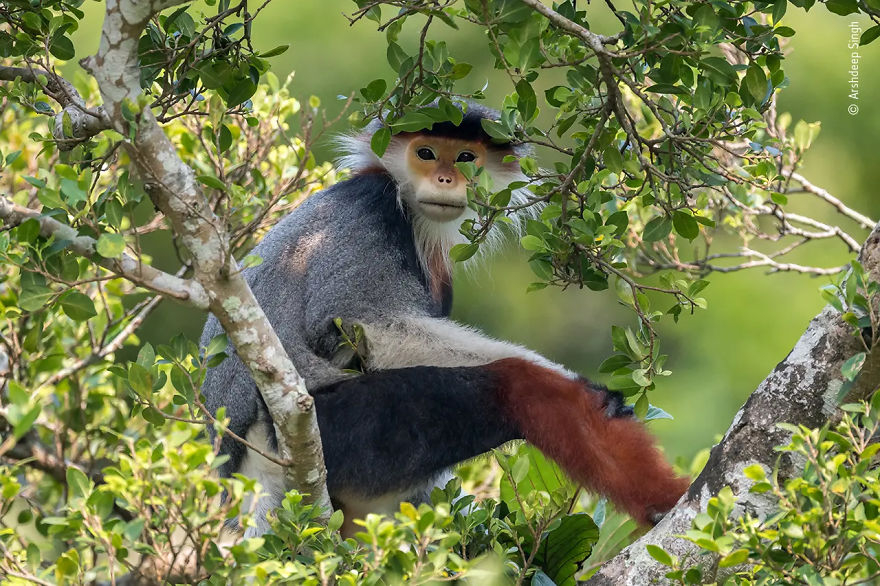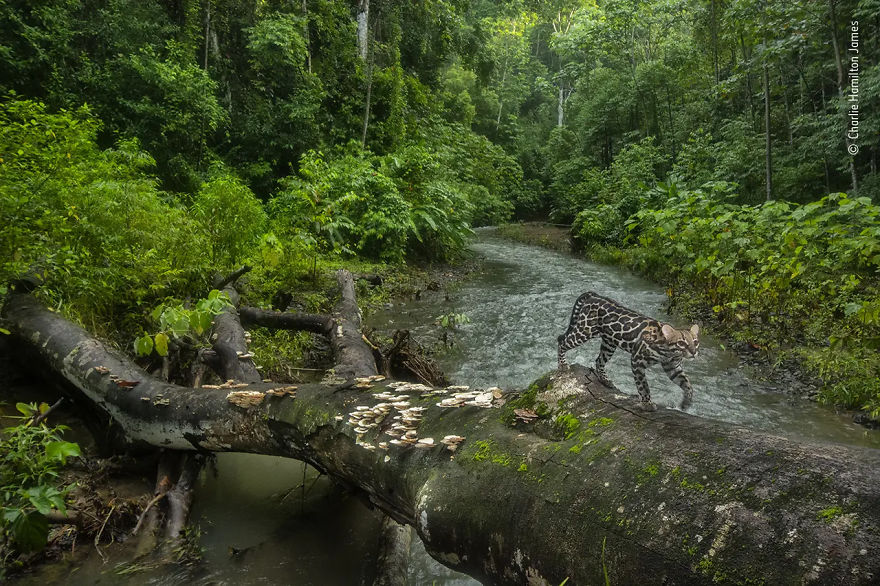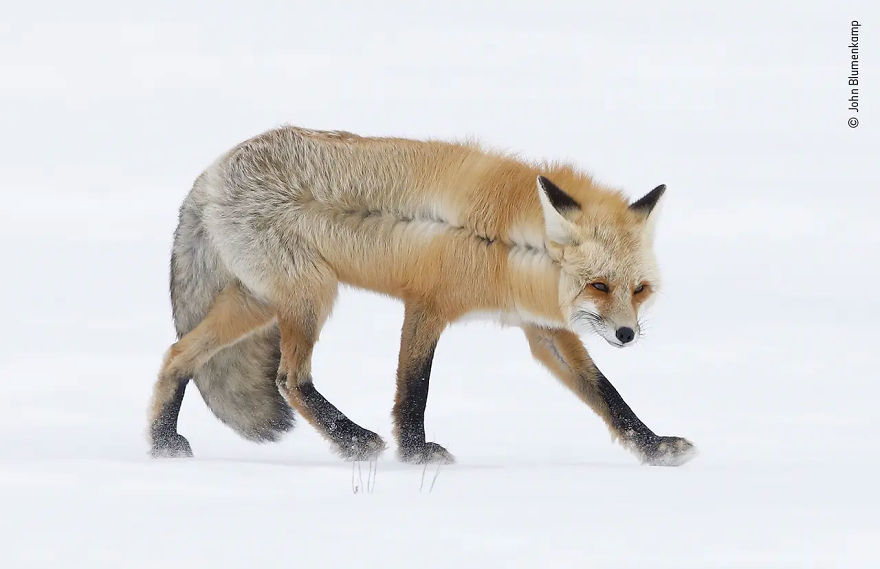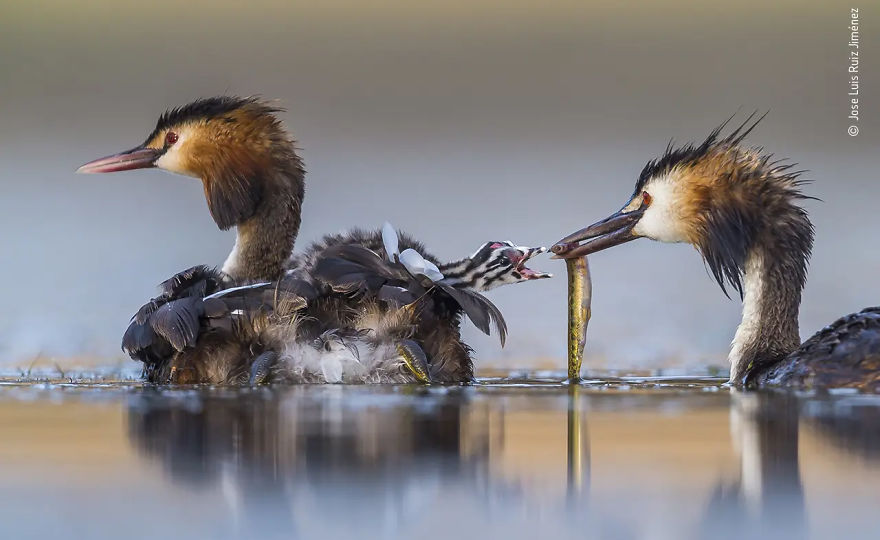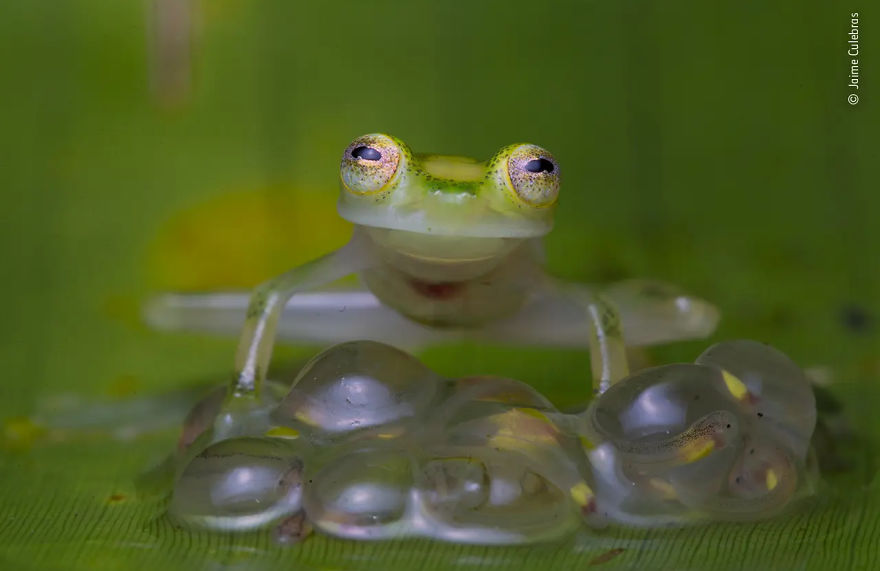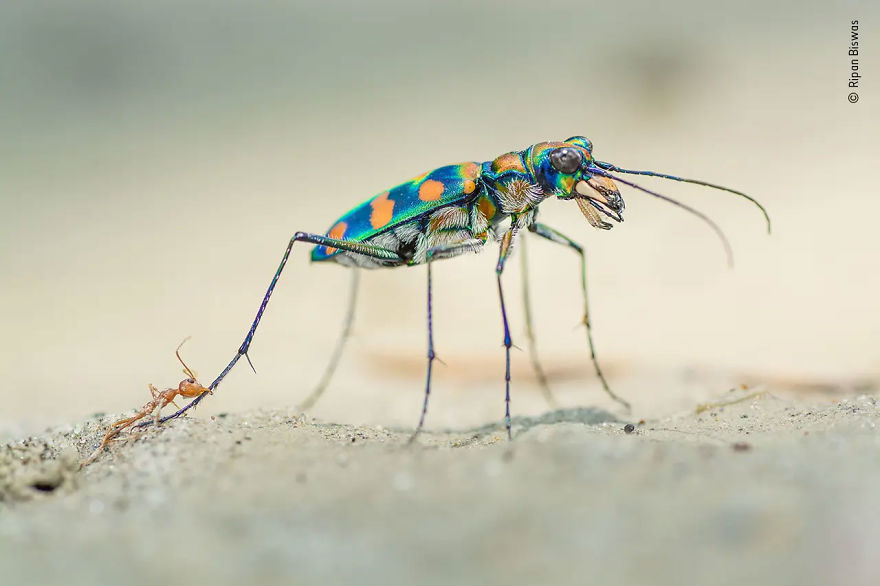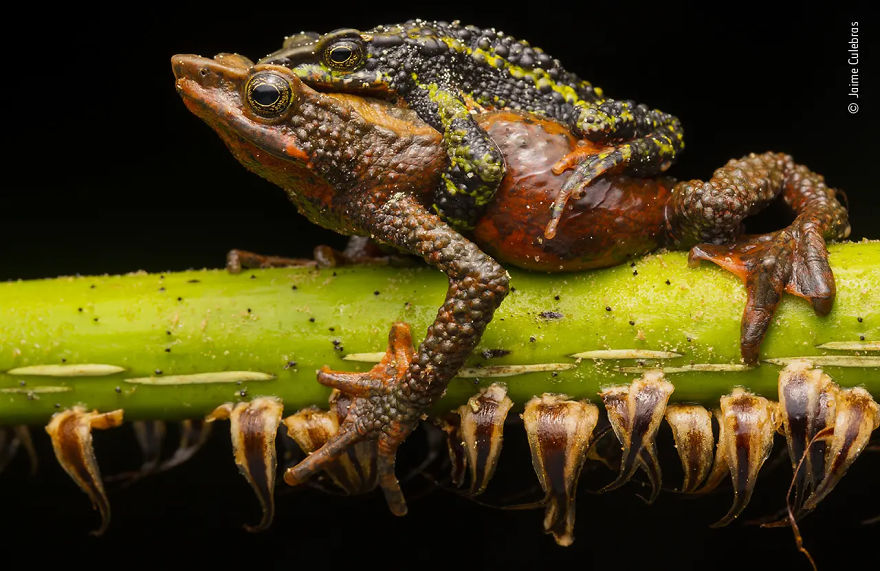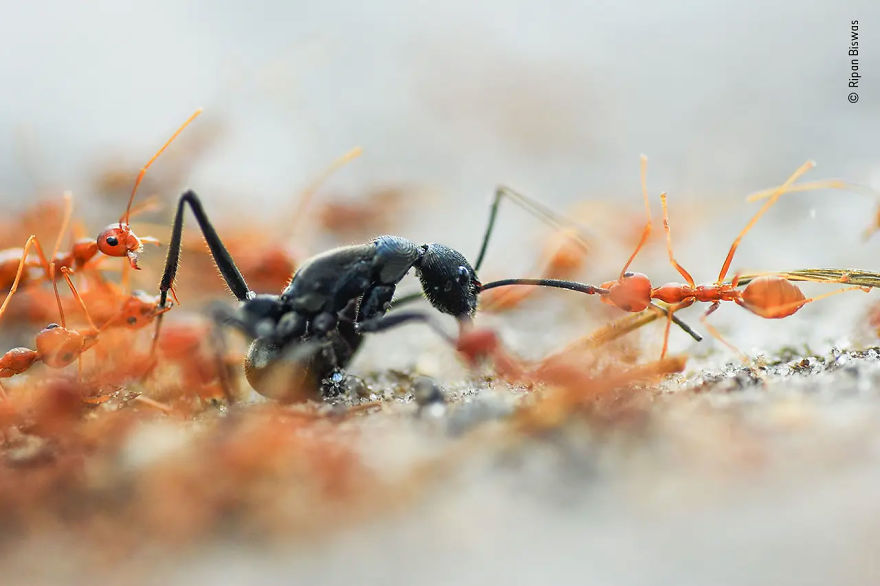
The Wildlife Photographer Of The Year 2020 Winners Have Just Been Announced (15 Pics)
The winners of the Wildlife Photographer of the Year 56 competition have just been announced, and the pictures are as stunning as always.
Selected from over 49,000 entries from around the world, they were revealed during an online awards ceremony live-streamed from the Natural History Museum, London on 13 October.
Kate Middleton, Duchess of Cambridge and patron of the museum, announced Sergey Gorshkov as this year's Wildlife Photographer of the Year for his magnificent image, The Embrace, of an Amur tigress hugging an ancient Manchurian fir in the Russian Far East. Amur, or Siberian, tigers are only found in this region and the Russian photographer took more than 11 months to capture this moment with hidden cameras.
Gorshkov's shot and the rest of the winners were selected from a shortlist of 100 images and will be exhibited at the Natural History Museum in London before embarking on a UK and international tour.
More info: nhm.ac.uk | Facebook | Instagram | Twitter
This post may include affiliate links.
Animal Portraits Highly Commended: "Night Hunter" By Jonas Classon
Having tracked this great grey owl’s every move for weeks, Jonas set out in his car, on the night of a full moon, to capture a photograph of the bird. When he spotted his subject, Jonas cast his headlights towards it and sneaked into the forest. He caught the owl raising its claw, poised to attack a vole.
While this owl’s large, forward-facing eyes enable it to see in dim light, it actually locates its prey by sound. Owls have more sensitive hearing than many other birds and employ this adaptation to their advantage. Using sound alone, great grey owls can even hone in on animals hidden under snow.
It’s majestic in a dark fantasy way. I dunno how to explain it lol.
Chair of the judging panel, renowned writer and editor, Rosamund 'Roz' Kidman Cox said in a statement that Gorshkov's photo depicts a scene like no other. "A unique glimpse of an intimate moment deep in a magical forest. Shafts of low winter sun highlight the ancient fir tree and the coat of the huge tigress as she grips the trunk in obvious ecstasy and inhales the scent of tiger on resin, leaving her own mark as her message. It's also a story told in glorious color and texture of the comeback of the Amur tiger, a symbol of the Russian wilderness."
Animals In Their Environment Adult Grand Title Winner: "The Embrace" By Sergey Gorshkov
Sergey scoured the forest for signs of Amur, or Siberian, tigers, searching for the best place to set up his camera trap. He knew his chance of photographing one was slim, but his mind was made up. ‘From then on, I could think of nothing else,’ Sergey says. After 10 months, his dedication paid off: he captured a rare glimpse of this magnificent tiger in its wild habitat.
These solitary cats exchange vital information, such as the need for mates, by leaving scent, hairs, urine and other markers on prominent spots, including tree trunks. In the far east of Russia, a population of around 500 Amur tigers persists, occupying a fragment of its former land. Under threat from habitat loss and poaching, these tigers are close to extinction.
Dr. Tim Littlewood, Natural History Museum's Executive Director of Science and jury member, added, "Hunted to the verge of extinction in the past century, the Amur population is still threatened by poaching and logging today. The remarkable sight of the tigress immersed in her natural environment offers us hope, as recent reports suggest numbers are growing from dedicated conservation efforts. Through the unique emotive power of photography, we are reminded of the beauty of the natural world and our shared responsibility to protect it."
Behaviour: Mammals Highly Commended: "Kids’ Game" By Yossi Eshbol
Yossi knew the ibex herd took the same route to find water and food every morning, so he was in position before first light. On cue, the ibex appeared. The adults walked nimbly around the cliff edge, but the kids couldn’t resist jumping over the ravine as ‘a game’, Yossi recalls. ‘This one bleated a few times then found the courage.’
Nubian ibex are a type of wild goat. They live in rocky mountains, deserts and shrublands, foraging for grasses and other plants to eat. The population of these nimble creatures is decreasing. The causes are the same as for so many other species: habitat loss, hunting and, most recently, drought.
The panel of experts went through a rigorous process of analyzing the images from both professional and amateur photographers as all of the finalists did an excellent job capturing the world's richest habitats, fascinating animal behaviors and extraordinary species.
But the show must go on. Open to photographers of all ages, nationalities, and abilities, the next Wildlife Photographer of the Year competition opens for entries on Monday, 19 October 2020. Also, important new categories focusing on people's impact on the planet, and the new jury have just been announced.
Associate sponsors for the upcoming exhibition at the Natural History Museum are renewable energy company, Ørsted, and legendary camera manufacturer, Leica.
Urban Wildlife Highly Commended: "Peeking Possums" By Gary Meredith
A parent possum (left) and its offspring peeped from their hiding place: the roof of a shower block in a holiday park. Every night that week, Gary had watched the pair squeeze through a gap to feed on the leaves of a peppermint tree. This particular night, the possums stuck their heads out to look at their photographer.
The common brushtail possum is a small and adaptable marsupial – a mammal with a pouch. It occurs naturally in Australia’s forests and woodlands, but has also adapted to urban living. While possums thrive in some areas, they have declined in others as changes in the pattern, frequency and intensity of fires have reduced the number of large trees.
They are just too damn cute. I am getting a pinky and the brain kinda vibe from them.
Animal Portraits Highly Commended: "Keep Looking" By Greg Du Toit
Through a delicate haze of grass, a lion returned Greg’s gaze as the pride rested. From his vehicle, Greg focused on the green veil, allowing just enough depth to reveal the subject beyond. He wished to convey the feeling of standing on the edge of a wilderness, looking in through a dividing curtain. ‘These lions are as wild as they get,’ he says.
The prides of lions on this reserve in Botswana encounter very few people. Elsewhere across sub-Saharan Africa, conflict with humans, as well as loss of habitat and prey, has resulted in a severe drop in lion numbers. Not many animals could threaten an African lion, particularly when healthy, yet its population has declined by around 30 per cent over the past 20 years.
It’s like one of those eye game thingy’s, you know where you have to find an image within patterns etc.
Plants And Fungi Winner: "Out Of The Blue" By Gabriel Eisenband
Gabriel set out to photograph one of the highest peaks in the Colombian Andes: Ritak’Uwa Blanco. Yet it was the foreground of senecio plants that caught his attention instead, the flowers shining bright yellow. As the day was unusually calm, Gabriel was able to shoot the flowing clouds without any blur of movement from the plants.
This senecio species is a member of the daisy family found only in Colombia. It is adapted to the extreme cold of the Andes and flourishes at high altitudes, though below the point at which snow remains on the ground year-round. The plant has proteins in its leaves and a dense covering of woolly, white ‘hair’, both of which stop it from freezing.
Wildlife Photojournalist Story Award Highly Commended: "The Lucky Ones" By Steve Winter
Clay, Daniel and Enzo cooled off at the Wild Animal Sanctuary in Colorado – one of a number of rescue centres.
Tigers like these can generate a lot of money as cubs, but, when grown, they are expensive to look after and dangerous. As a result, adult tigers are often unwanted.
I absolutely adore tigers, but would I ever have the desire to have one. HELL NO, they are wild animals and belong there, they are not pets,
Urban Wildlife Highly Commended: "The Village Cat" By Masood Hussain
Masood spent the evening tracking a tiger in a nearby forest. Just as he was heading home at sunset, his driver spotted this big cat, lying on the wall of an abandoned village school. Finding himself short of time as the light faded, Masood selected a high-sensitivity setting, or ISO, and shot hand-held, risking camera shake. But the risk paid off. Leopards are highly resourceful cats. They have survived in many human-occupied regions by adapting to hunt dogs and livestock.
Even so, their population is shrinking. In India, the main threat to leopards is poaching for the illegal trade in their skins and body parts. They are also persecuted in areas of development, where wild land is being replaced by housing, roads and mining.
Behaviour: Invertebrates Highly Commended: "Big Bat Bloodsucker" By Piotr Naskrecki
A scientist caught this bat during a biodiversity survey. When Piotr spotted the parasite on the bat’s head, his interest was immediately aroused and he quickly started to take photographs for research. Piotr didn’t have much time before the bat was released, but he did manage to capture the bristles and claws of its firmly attached stowaway.
At first glance, the smaller animal looks like a spider, but gripped to the head of the Mozambican long‑fingered bat was actually a six-legged, wingless bat fly. This bloodsucking parasite moves around on its host, but usually sits on the lower back, out of reach. When a bat is in flight, the fly may sit on its host’s head instead.
Behaviour: Mammals Winner: "When Mother Says Run" By Shanyuan Li
This rare scene of playful Pallas’s cats took six years to capture. Hiding opposite an old marmot hole in which a family of cats had built its lair, Shanyuan waited. Hours of patience were rewarded when three kittens emerged to play while their parent kept a lookout. Upon the sighting of a Tibetan fox nearby, the youngsters were swiftly ushered back inside.
Typically active at dawn and dusk, Pallas’s cats have flat heads, low-set ears and a light colouring, which help conceal them while hunting. Their habitat – mainly the grasslands of China, Mongolia and the Tibetan Plateau – faces disruption from mining and farming. Farmers poisoning rodents depletes the cats’ prey and subjects them to secondary toxicity, causing numbers to decline.
Animal Portraits Winner: "The Pose" By Mogens Trolle
The proboscis monkey cocked its head slightly and closed its eyes. It posed for a few seconds, as if in meditation. A wild visitor to a sanctuary feeding station, this monkey was ‘the most laid-back character’, says Mogens. Its peaceful expression was quite unlike anything he had seen before.
As this monkey matures, its distinctive nose will signal its status and amplify its calls. A male’s nose can eventually grow so big that it hangs over its owner’s mouth. Found only on Borneo and nearby islands, proboscis monkeys are endangered: they depend on threatened forests and are hunted for food and traditional medicine.
I see an old wise man relishing in his thoughts in this photo.
Animal Portraits Highly Commended: "Eye Of The Drought" By Jose Fragozo
An eye blinked in the drought-stricken mud pool as the hippopotamus emerged to take a breath. The challenge for Jose, watching from his vehicle, was to catch the eye when it was open. Having observed hippos for years, he knew that they only come up for air every three to five minutes.
Hippos spend their days submerged in water to stay cool and prevent their sensitive skin from cracking in the hot sun. They are vital in both aquatic and land ecosystems as their dung provides important nutrients. However, when rivers run dry, the high dung concentration depletes oxygen and kills aquatic life.
Under Water Highly Commended: "The Current Of Life" By Laurent Ballesta
Thousands of convict surgeonfish congregated to spawn in a narrow channel leading to the South Pacific Ocean – and sharks gathered to feed on them. Laurent photographed the fish scattering as the last rays of sun lit their billowing eggs. He spent four years diving around this remote coral reef observing its marine life.
The phenomenon pictured takes place every new moon at sunset, concluding in under an hour. In order for their eggs to be swept away into the ocean by the current ripping out of the lagoon, convict surgeonfish will run the risk of being eaten by grey reef sharks. Far from the shallows, the eggs are protected from a wealth of small predators.
If you scroll down the photo a lil to get past the water ripples and sun reflection, it looks like the sharks and fish are flying in the sky.
10 Years And Under Winner: "Perfect Balance" By Andrés Luis Dominguez Blanco
Andrés had seen stonechats hunting insects in a meadow near his home. So he asked his father to drive him there in order to use the car as a hiding place for taking photographs. Looking through an open window, he watched this particular stonechat perch on a plant. As the bird maintained perfect balance, Andrés made the perfect frame.
The stonechat is a small bird with a call that sounds like two stones tapping together, hence its name. It is widespread throughout the heaths and bogs of southern Europe, feeding on insects, seeds and fruit like blackberries. Some – including the one pictured – are resident all year round, while others fly to northern Africa for winter.
Earth’s Environments Winner: "Etna’s River Of Fire" By Luciano Gaudenzio
Lava flowed from a great opening on the side of the volcano, running along a huge tunnel and re-emerging further down the slope as an incandescent red river. In order to witness the scene, Luciano trekked up the volcano’s north face for several hours. He set the hot flow against the blue gaseous mist to capture, what he describes as, ‘the perfect moment’.
Mount Etna, the most active volcano in Europe, has been erupting continuously for almost 30 years and threatens around 900,000 people. Phenomena like lava flows and lava fountains are common, with ash plumes less frequent. This is just the most recent phase in 15,000 years of volcanic activity – and a stark reminder of Etna’s power.
Earth’s Environments Highly Commended: "When The Rain Came Rolling In" By Zack Clothier
Zack woke early and hiked to a nearby lake to see the sunrise. It had barely rained for six months and the lake had receded in the drought, leaving massive tiles of dried mud around the water’s edge. With his lens close to the ground, Zack used a technique called focus stacking, combining multiple images to achieve this single photograph.
The southwestern USA recently experienced its driest period since the 1500s. The temporary habitats created by such severe droughts can pose problems for animals that need to cross the exposed mudflats to access water. As droughts become increasingly extreme due to warmer temperatures caused by climate change, impacts may be felt more widely.
Plants And Fungi Highly Commended: "The Forest Born Of Fire" By Andrea Pozzi
The monkey puzzle trees, or Chilean pines, stood tall against a backdrop of late-autumn forest. Andrea hiked for hours to a ridge and waited for the perfect light, just after sunset, to capture this scene’s colours. The trunks gleamed like scattered pins on the landscape, the whole world clothed in the strange forest fabric.
Typically found in parts of Chile and Argentina, monkey puzzle trees sometimes live for more than 1,000 years. With their thick, protective bark and specially adapted buds, these trees are able to withstand milder forest fires. Yet they are now endangered, at risk from land clearance and larger fires as their habitat becomes hotter and drier.
"Monkey puzzle" is also the nickname Audrey Hepburn's dad gave her. She will be remembered as long as those beautiful trees live.
Urban Wildlife Highly Commended: "The Art Of Recycling" By Yosuke Kashiwakura
Fascinated by crows’ artful nests, Yosuke was keen to photograph the birds’ habits without disturbing them. His chance arose when this nest was removed as a hazard by municipal workers. Coat hangers scavenged from balconies had been arranged among the twigs and twine. To reveal the design without distraction, Yosuke laid a black cloth beneath the nest.
City-living wildlife – and crows particularly – are opportunistic. They make the most of what they find, often with intriguing results. Many urban birds use human-made materials for their nests, which, however unusual to look at, can sometimes cause issues. For instance, clashes between the crows’ metal architecture and city power cables may result in blackouts.
Animals In Their Environment Highly Commended: "Wolf Mountain" By Lorenzo Shoubridge
Lorenzo was determined, having devoted six months to finding the perfect spot from which to photograph wolves. After securing his camera trap to a tree, he spent hours adjusting the settings to include the mountain backdrop. As these wolves loped along a regular route, their coats a mirror of the surroundings, Lorenzo achieved this atmospheric shot.
In recent years, the wolf population across the Italian Alps has been increasing slowly. Yet these iconic carnivores are not universally welcomed. Fear and concern about livestock are factors, as is a lack of understanding about the wolf’s vital role in the ecosystem. By preying on large herbivores like deer, wolves control their numbers, thus allowing vegetation to grow.
Look closely and you can see there is actually a lot of them, like the whole pack, in fact I think one of them is howling at the moon!
Animal Portraits Highly Commended: "Top Picker" By Max Waugh
Looking up, Max was astonished to see a tayra peering down at him. He had occasionally encountered these elusive mammals bounding along the forest floor, yet this one was high in a Panama rubber tree, picking fruit with its teeth. Aiming his camera straight up to the clouds, Max captured this rare shot.
Roughly the size of a small dog, tayras are mustelids – a family that includes badgers, wolverines and weasels. Tayras are omnivorous and eat a wide range of food, from small mammals, fruit and invertebrates to reptiles, birds and carrion. They also have a liking for honey.
Under Water Highly Commended: "Speeding Squid" By Songda Cai
Floating in the dark sea during his night dive, Songda waited for something interesting to photograph. Then he spotted this diamondback squid. Using his underwater lighting, Songda revealed the squid’s head and the membranous fringes of its suckered arms. A long exposure allowed the passing animal to paint its own path across the frame.
Diamondback squid are normally slow movers, gliding unhurriedly through the water. But they can also produce a burst of jet-propulsion speed by contracting the soft, muscular cavity around their body – the mantle – and forcing water out through a funnel. They can then direct the jet by moving the funnel, accelerating towards prey or away from predators.
11-14 Years Winner: "A Mean Mouthful" By Sam Sloss
While diving, Sam stopped to watch a group of clownfish dart around a magnificent sea anemone – an animal related to jellyfish. Sam was intrigued by the expression of this particular fish, which kept its mouth open. Only when he downloaded his photos did he see the tiny eyes peeping out from within. Sam’s shot revealed three different, but interconnected, life forms.
This fish had a tongue-eating louse in its mouth – a parasite that attaches itself to the base of a host’s tongue in order to suck blood. In the wild, clownfish are found living among the tentacles of a host sea anemone, which protects them and their developing eggs. In return, the fish remove debris from the sea anemone’s surface and chase away predatory butterflyfish.
Animal Portraits Highly Commended: "The Beak" By Csaba Daróczi
One summer evening, Csaba waited for the last birds of the day near his woodland pond. As dusk fell, a blackbird flew in and stood alert for a few seconds – long enough for Csaba to compose this minimalist portrait. The bird’s bright beak and eye-ring penetrated the darkness, its form barely visible in the shadows.
The Eurasian blackbird has large eyes relative to its body size – a trait that allows it to find food at low light levels. Its eyes are positioned on the sides of its head, which gives it excellent peripheral vision. As a result, it must cock its head to catch sight of prey. Originally woodland birds, blackbirds now visit forests, farmland and gardens.
10 Years And Under Highly Commended: "Badger Caught Worming" By Fred Začek
Fred’s family visits the same park every summer. Out with his camera one evening, he caught sight of a badger feeding in the open. Despite badgers more typically being found in the undergrowth, Fred was keen to photograph this one against a ‘clean background’, so he crept closer. After half an hour of stalking, his shoes soaked in dew, Fred’s wish came true.
The European badger uses its long claws to dig for earthworms, which can comprise a large portion of its diet. Omnivorous and resourceful, however, the badger adapts its intake depending on the season and on what it can find. Dietary options include insects, small mammals, birds, fruit and human food waste.
11-14 Years Highly Commended: "Treetop Douc" By Arshdeep Singh
Arshdeep asked to join his father’s business trip to Vietnam after reading about the endangered red-shanked douc langur that lives there. He had just three days at the nature reserve and only on the last day did a douc appear in a nearby tree. Arshdeep managed to shoot clear of the leaves, capturing this fleeting glance.
These striking primates are found only in Vietnam, Laos and Cambodia, distinguished by their bright red ‘stockings’. They live in either families or larger groups. During the cooler hours of the day, doucs will forage for leaves, flowers and fruit. Loss of habitat and hunting threaten their future.
He looks like he's dressed and ready to go off to some swanky party. Amazing picture young man!
Behaviour: Mammals Highly Commended: "The Rat Game" By Matthew Maran
Matthew spent several years photographing the foxes that live on an allotment near his home. On this particular evening, as some of the younger foxes were at play, one ran out of the bushes with a dead rat in its mouth. The others began squabbling over the rodent and a tug-of-war developed. Flashing a determined stare, this fox held tight to its trophy.
With their long, narrow jaws and thin canine teeth, foxes are adapted to hunt small rodents, including juvenile rats. Adult rats are a more daunting prospect as they can inflict serious injury. Urban foxes, rather than hunting rodents, often consume food they scavenge from human populations.
Wildlife Photojournalism Highly Commended: "Memorial To The Albatrosses" By Thomas Peschak
These birds – albatrosses and white-chinned petrels – were fatally attracted to the rich pickings of longline fishing boats. However, the display Thomas photographed actually illustrates a conservation success story. In 2017, there was a reduction in the number of seabirds caught and killed on longlines set by Japanese tuna-fishing boats in the waters around South Africa.
In longline fishing, baited hooks are trailed on lines through the water. When small seabirds pull the hooks up to the surface to snatch the bait, larger birds often hijack their efforts, sometimes hooking themselves and drowning. Improved fishing practices mean that, off South Africa’s coast, fewer birds now suffer this fate. Yet over 300,000 a year are still killed by longlines globally.
Wildlife Photojournalist Story Award Winner: "Backroom Business" By Paul Hilton
In the rainforest, this macaque would have lived in a large group.
Paul found it sitting alone, chained to a cage, at an Indonesian animal market. He was only allowed to photograph it when the trader believed he was interested in making a purchase. The young macaque was perhaps later sold as a pet, to a zoo, for biomedical research or to be eaten.
Wish governments, officers etc would do more to stop this s**t.
Animals In Their Environment Highly Commended: "Ocelot On The Highway" By Charlie Hamilton James
The fallen tree, bridging a small river, shouted ‘wildlife highway’ to Charlie. He spent weeks perfecting the set-up of his camera trap so that it would reveal elusive species in daylight as they emerged from the forest and crossed the bridge. Over several months, he captured images of many animals, including this handsome ocelot, the early morning light brightening its face.
Osa is one of the few places in Central America that can still boast five species of wild cat – among them the ocelot, puma and jaguar. Yet these animals are under pressure from habitat fragmentation and loss of prey. A special network of camera traps is monitoring the cats’ habits and behaviour in order to better understand their conservation needs.
Ocelots are pretty rare, so this was a once in a life time experience for the photographer
Animal Portraits Highly Commended: A Fox For All Seasons" By John Blumenkamp
Hunting in a snow-covered valley, this American red fox was hit side-on by a gust of wind, its thick winter coat parting to reveal its fine fur underlayer. John watched the fox for hours – withstanding the windy weather and sudden drops in temperature – to take this stark image of a winter survivor.
With its winter coat, the red fox is well equipped for cold conditions. It can survive in a variety of habitats and has a remarkable ability to adapt, supported by its broad diet. After humans, red foxes have the largest natural range of any mammal found on land.
Animal Portraits Highly Commended: "Taiga Tiger In The Night" By Sergey Gorshkov
Sergey had never set eyes on a wild tiger when he resolved to photograph one in the east of Russia. He found his ideal setting, minus the cat, and hid his camera on a tree. A few days later, a young Amur, or Siberian, tiger gave Sergey the portrait he had hoped for, the colours of its coat harmonising with the surroundings.
Russia’s remote eastern taiga forests, or ‘snow forests’, are this cat’s northernmost reach, home to the Amur tiger. There is a small population in neighbouring China and it is uncertain whether there are any left in North Korea. While the number of these tigers in Russia dropped to around 20 or 30 in the 1930s, it has grown following conservation and a ban on poaching.
Behaviour: Mammals Highly Commended: "The Snatch" By Peter Lindel
Peter knew the leopard was crouched behind a bush, surveying an adult warthog and its piglet. As rain started to fall, the two warthogs were briefly distracted and the leopard began to move. ‘The piglet didn’t stand a chance,’ says Peter. The adult warthog attempted to charge, but in vain. The leopard snatched its meal and disappeared up a tree.
Combining strength and speed, the leopard is a formidable hunter. Once it seizes its prey, it may hoist the catch up a tree to store and eat later, away from competing predators like lions and hyenas. Given the chance, a warthog is also capable of speed and could even injure a leopard with its four sharp tusks.
i know it's sad for the warthog, but at least they are not being hunted to extinction as hunting trophies.
Behaviour: Mammals Highly Commended: "High-Altitude Pursuit" By Haiyuan Tong
Approaching a herd of Tibetan gazelle, a pack of Himalayan wolves split up and encircled its prey. But the gazelle quickly scattered. Haiyuan tracked the wolves for the next two hours, watching them repeatedly attempt to infiltrate the herd. Finally, they isolated a youngster. The scene then became a chase, the hunters taking turns to run down the gazelle.
The wolves that live at high altitudes across the Himalayas and the Tibetan Plateau can tolerate low oxygen levels and extreme cold, though research is needed to uncover exactly how they are adapted to such habitats. Meanwhile, gazelle are in decline due to illegal hunting, competition with domestic livestock, and development taking place on their home ranges.
Under Water Winner: "The Golden Moment" By Songda Cai
Out on a night dive, Songda saw all sorts of larvae and tiny animals migrate up from the depths of the ocean, under cover of darkness, to feed on surface-dwelling phytoplankton, or microalgae. Then came this magnificent diamondback squid. It hovered beneath Songda for just a moment, basking in his nightlight, before disappearing in a flash of gold.
The squid pictured was just a hatchling, but, like an adult, it propelled itself with undulations of its triangular fins, sprinting away when faced with danger. Special organs in a diamondback squid’s skin – chromatophores – contain sacs of pigment that allow the animal to change colour. Other organs can reflect and scatter light.
Baby Kraken: " Mommy! Mommy! Look at me, I am papa defending the sea from those foul humans! "
Wildlife Photojournalism Highly Commended: "
This short-finned pilot whale was left unable to swim after its tail was severed by a boat propeller and its body attacked by sharks. In the water, Francis could hear the injured whale’s cries, as well as those of its family group, which circled protectively. ‘It was the saddest day of my career,’ says Francis, who has photographed marine life for 20 years.
These deep waters host more than 20 whale and dolphin species. With increasing boat tourism and no speeding regulations, propeller strikes are a constant threat, especially to pilot whales, which recover from long, tiring dives at the water’s surface. Speed restrictions can reduce collisions.
Wildlife Photojournalism Highly Commended: "The Price Of Oil" By Andrew S Wright
‘Nodding donkeys’, or pumpjacks, drive the deep, underground pumps in California’s densest oil field. Andrew took this photograph from three kilometres away, the compression of his telephoto lens emphasising the concentration of machines. The graphic scene has an otherworldly feel: an alien landscape crawling with insect-like robots and attendant electricity poles.
Although more than two billion barrels of oil have been produced at Kern River, the remaining supply is more difficult and energy-intensive to extract. Due to falling oil prices, many Californian wells are now idle or abandoned. Unless properly treated, they will leave a toxic legacy, leaking methane and contaminating the air and groundwater.
Behaviour: Amphibians And Reptiles Winner: "Life In The Balance" By Jaime Culebras
Jaime walked for four hours to reach this location, determined to share his passion for glass frogs. He was thrilled to catch sight of one eating a spider, its eyes like shimmering mosaics. Serenaded by a frog chorus in torrential rain, Jaime claimed the first-ever picture of this species feeding.
Distinguished by the yellow spots on its back and the lack of webbing between its fingers, the Manduriacu frog is found only in a small area in the foothills of the Andes. It is threatened by habitat loss and environmental contamination associated with cattle ranching, agriculture and mining. This frog could soon face extinction.
Wildlife Photographer Portfolio Award Winner: "Featherweight" By Ripan Biswas
This gang of weaver ants climbed higher, hauling a feather that would perhaps be eaten as a valuable source of protein. Ripan spotted the ants’ destination overhead – a football-sized nest at the end of a branch – and noted the level of effort it would take for the insects to reach it. He approached cautiously and used a wide-angle lens to capture their endeavours.
A weaver ant colony may number half a million ants and can occupy multiple nests among the branches of a tree. It is ruled by a single, egg-laying queen ant. The workforce comprises smaller workers, who look after the colony’s brood, and slightly larger workers, who hunt for food and protect the nests, which are made using larvae silk.
15-17 Years Young Highly Commended: "Snow Moose" By Matthew Henry
Waiting in the car, Matthew spotted this moose in the snow. As it approached him, Matthew’s chance for a creative portrait came when the moose paused to drink from a puddle. Every few seconds, the animal looked around, its head contrasted against its dark, wet fur. Matthew experimented with shutter speeds to capture both the snowfall and the details of the moose’s face.
The moose, or elk, is the largest living species of the deer family, known for its long, unmistakable muzzle. It also has long legs, which help it stride through snow. Particularly heavy snowfalls, however, can make progress slow and attack from grey wolves more likely. The moose is adapted for freezing conditions in winter when it grows a thick, insulating undercoat.
Animals In Their Environment Highly Commended: "Arctic Exposure" By Espen Bergersen
When Espen saw two Svalbard rock ptarmigans pause to rest on the jagged slopes, he dismounted his snowmobile and began to crawl towards them. Taking a wide angle, he framed the birds in their rocky landscape, the wind-blown ridges enhancing his composition. The monochrome scene was broken by small bursts of colour from the lichens.
This rock ptarmigan is the only land bird that lives all year round in Svalbard – a group of islands between Norway and the North Pole. In their white winter plumage, rock ptarmigans are almost invisible. They are threatened by climate change as pink-footed geese, which compete with them for habitat and food, are thriving due to warmer temperatures.
Behaviour: Birds Winner: "Great Crested Sunrise" By Jose Luis Ruiz Jiménez
Up to his chest in water, Jose Luis shot this intimate moment with a family of great crested grebes. When one parent emerged with damp feathers and a fish, Jose Luis was lucky that not a breath of wind rippled the water. A stripy-headed chick stretched out of its sanctuary, open-beaked, to claim the tasty meal.
Grebes are at their most elegant in the breeding season when ornate plumage is used in courting. They build a nest of aquatic plant material, often among reeds at the edge of shallow water. Chicks venture out within just a few hours of hatching, hitching a snug ride on a parent’s back.
11-14 Years Highly Commended: "Paired-Up Puffins" By Evie Easterbrook
Evie longed to see puffins, so, when school broke up, she and her family took a two-day trip to witness the birds in their habitat. She set up her camera by the puffins’ burrows, noticing the adults returning with mouthfuls of sand eels for their young, and then decided to concentrate her observations on this pair with its vibrant breeding coloration.
Atlantic puffins form pairs for several years, sometimes even for life. During the breeding season, they have black ‘eyeliner’ and brightly coloured bills. Bill size and colour are major attractors to potential mates. Puffins worldwide are in decline: climate disruption has reduced the availability of sand eels – a staple of their diet.
Behaviour: Invertebrates Highly Commended: "Lights Of Passion" By Aishwarya Sridhar
Although the leopard-frequented forest could be ‘terrifying’, it was the perfect place for Aishwarya to look for fireflies. After two hours of hiking, she found a tree dusted in gold from the bioluminescence of thousands of fireflies. Shooting 27 images over a 24-second exposure and combining them using focusstacking software, she highlighted the vibrancy of this scene.
Fireflies are a type of winged beetle that use light to lure potential mates. Of the many species, each has a distinct pattern and intensity of light in order to recognise its own kind. Fireflies are affected globally by habitat destruction and light pollution, which can make them lose track of time and position, disrupt their mating or even blind them.
Plants And Fungi Highly Commended: "Stream Of Light" By Jorma Vahala
This spot is one of Jorma’s favourite places for photographing familiar subjects in creative ways. So he was ready when sunbeams reached through the canopy and a breeze ruffled the water. Trial and error gave him the effect he wanted: a common flower made memorable by a background of rippling light, reflected from the stream.
Along the wetlands and streams of southern Finland, marsh marigolds start to bloom in May. Large, golden-yellow flowers mark them out as relatives of the buttercup. They flourish in damp shade throughout the northern hemisphere and their flowers brighten the banks of any waterway, enriching forest landscapes.
Earth’s Environments Highly Commended: "The Blue Pool On The Top Of The World" By Alessandro Gruzza
Alessandro had visited this spot more than 50 times, but he had never seen these conditions. The water had frozen to a rich blue, the first snowfall of the year edging the pond’s curves with a delicate beauty. Alessandro composed his image so that the sky and foreground would mirror each other, bisected by the dramatic Dolomites.
The Lagorai mountain range is formed of fine-grained volcanic rock. This makes the ground impermeable, so rainwater tends to sit on its surface, forming many lakes and ponds. The nearby Dolomites, once a geological mystery, are now known to have originated as ancient coral atolls, elevated to great heights over the past 60 million years.
Behaviour: Amphibians And Reptiles Highly Commended:" Father Protector" By Jaime Culebras
Jaime spotted this glass frog standing guard over its eggs. Keen to photograph it, he set up his kit in the darkness. Blending the green hues of the frog’s body into a soft background, Jaime revealed the small amphibian’s red heart through the transparent skin of its belly.
Atrato glass frogs lay as many as 25 eggs each on leaves hanging over streams. Males then cling on to protect their developing offspring from predators and dehydration. Once hatched, the tadpoles will drop into the water below.
Behaviour: Invertebrates Winner: "A Tale Of Two Wasps" By Frank Deschandol
Frank chose a wasp burrow out of direct sunshine so as not to let too much light into his camera. He then set up an infrared beam, which, when broken by a wasp, triggered a very fast shutter system. In this perfectly balanced composition, Frank captured not one, but two, of the small subjects – the wasp on the right measuring only six millimetres.
These two wasps have very different approaches to laying their eggs. The cuckoo wasp (right) lays its eggs in the burrows of solitary digger wasps. When its young hatch, they feed on their host’s egg or larva and then the food store. The redbanded sand wasp (left) lays eggs in its own burrow, supplying a caterpillar for each of its young to eat.
Behaviour: Invertebrates Highly Commended "The Spider’s Supper" By Jaime Culebras
Jaime trekked a long distance to this stream in the hope of finding glass frogs. Instead, he found a wandering spider devouring glass frog eggs. Jaime caught the spider as it grasped the thin jelly coating between its fangs, steadying an egg with its palps – mouthparts that help with sensing and feeding.
Wandering spiders are usually sit-and-wait predators, pouncing on a wide range of insects and small vertebrates before injecting them with digestive juices and sucking in the liquefied prey. But this clutch of glass frog eggs would have been an irresistibly easy meal.
Behaviour: Invertebrates Highly Commended: "Sugar Suckers" By Bernhard Schubert
Bernhard discovered this small party while out on a night hike. A group of ants was surrounding a planthopper in order to feed on the sweet honeydew it excretes as a digestive waste product. Remaining poised, despite the large, nocturnal wasps buzzing around his headtorch, Bernhard was able to catch the feasting formation.
Giant forest ants are among the largest ants in the world: these particular workers measure just over two centimetres each. Yet, despite their size and formidable pincers, they feed mostly on honeydew. In return for the energy-rich drink, ants can offer planthoppers protection from predators and parasites.
Wildlife Photojournalism Highly Commended: "Tiger Tiger, Burning Out" By Paul Hilton
Indonesian officials torched a pyre of wildlife contraband, confiscated from illegal trade, which included elephant tusks and tiger trophies. Such highly prized possessions are often seen as status symbols. Paul’s image highlights Indonesia as a global hub for the lucrative trade in wildlife, dead or alive.
This international industry makes more than $20 billion a year. Indonesia’s Sumatran tiger – the smallest of all tigers – is critically endangered: fewer than 400 remain. The country’s other two types of tiger have already been hunted to extinction. Tiger poaching continues, even in protected areas, supplying domestic and international demand for products like skins, teeth, taxidermies, bones and tiger bone wine.
Wildlife Photojournalist Story Award Winner: "The Blind Leading The Blind" By Paul Hilton
Animals used for entertainment can live painfully hard lives.
This blind bear was made to pose for tourist photos in a theme park in Guangxi, China. The crude ring through its nose was a constant torment. ‘It’s torture,’ says Paul, ‘one false move and it is in so much pain.’
I am absolutely disgusted by this, so angry that people can treat animals like that.
Rising Star Portfolio Award Winner: "The Pull Of The Meadows" By Alberto Fantoni
Alberto visits the same meadow every spring, where he knows fieldfares gather to feed on earthworms. Lying flat on the grass, he witnessed this particular ‘cartoon scene’. The fieldfare was pulling and then pausing, dislodging the worm bit by bit, but not using so much force as to snap it and leave half a meal behind.
Fieldfares are gregarious thrushes that forage for invertebrates on the ground. Earthworms are their main food source during spring and summer, so they must harvest enough to stay alive. Normally, a bird will pull out a worm in one go. But, in this case, the earthworm hung on, contracting its body underground to anchor itself with the tiny bristles that line its body.
10 Years And Under Highly Commended: "Caught In The Act" By Kryštof Bartuška
Kryštof was staying in a hut with his young naturalists’ club. One beautiful morning, while the others slept, he and a friend crept out to take pictures. Spotting a northern chamois, they began to stalk it up precipitous terrain. But then it disappeared behind a rock. Just as the children began to worry that they might fall, the chamois reappeared, catching them out.
Chamois are related to sheep and goats, and live in mountainous parts of Europe, particularly the region around Turkey and the Balkans. They are nimble creatures, grazing the slopes of their steep, rocky homes, eating grass, leaves and buds at altitudes of up to 3,000 metres.
10 Years And Under Highly Commended: "City Signature" By Vidyun R Hebbar
This signature spider hung above a roadside and Vidyun watched it every weekend for a month, noticing how it regularly rebuilt its web. These spiders are common in his local area in Bangalore, so Vidyun set out to frame this one against the backdrop of an apartment block. He wanted to show how ‘the spider was living among us in my big city’.
Signature spiders decorate their fine webs with zigzags of silken threads, or stabilimenta, which sometimes resemble letters. The spiders build new webs – with different zigzag ‘signatures’ – every day, usually in supportive vegetation, wherever a foothold can be found. The purpose of these ‘signatures’ could be to advertise the traps, deterring birds from crashing through.
Under Water Highly Commended: "Underwater Galaxy" By Domenico Tripodi
Having dived in the same area his whole life, Domenico knew that the stiff breeze on this particular day would be a challenge. But, upon descending beneath the choppy waves, he was rewarded, finding himself ‘in an incredible sea of tunicates’ – marine invertebrates that form long, star-studded-ribbon-like colonies. Domenico framed a jellyfish against the celestial curtain.
Known as the mauve stinger, this relatively small jellyfish can grow to anywhere between three and 12 centimetres across. Although little, it can form large blooms, which are potential hazards to swimmers. Unusually for jellyfish, this species has stinging cells on its umbrella-shaped bell, as well as on its tentacles and the oral arms that trail from around its mouth.
Urban Wildlife Highly Commended: "House Cat" By Nayan Khanolkar
This porch was on a route regularly taken by leopards, so Nayan asked the family who lived there if he could shoot some photographs. Having secured permission, he set up his camera trap, taking advantage of the artificial light percolating through the latticed wall. His picture conveys the versatility of a remarkable predator, as well as hope for our future coexistence.
The Warli people, based near Mumbai, have learnt to live alongside leopards. The cats come in at night from the nearby national park. Food thrown away on the streets attracts dogs, which are easier pickings for the leopards than the deer in the woods. Attacks on humans do happen, but are rare.
Wildlife Photojournalism Winner: "Show Business" By Kirsten Luce
One hand raised, signalling to the polar bear to stand, and the other holding a rod, the trainer directed the bear through the ice-rink show. A wire muzzle was used to prevent the bear from biting and blue safety netting surrounded the circus ring to protect the audience. This bear is one of four animal performers in the world’s only polar bear circus.
Sensitive to their environment, polar bears do not fare well in captivity, with many dying young. Yet they are popular exhibits in zoos across the globe, even in hotter climates. Back in their Arctic home, these bears are threatened by climate change, as well as habitat destruction from oil exploration work.
It's muzzled! I am disgusted and disappointed by the freedom taken away from this majestic creature.
Ildlife Photojournalist Story Award Winner: "It Starts When They’re Young" By Paul Hilton
A chimpanzee entertained the crowd in an Animal Olympics show at the Shanghai Wildlife Park, China.
Although these apes are protected under international law, the laws aren’t always enforced and documents are sometimes faked. Only baby chimps can be transported – each costing around $10,000.
Rising Star Portfolio Award Winner: "Great Catch" By Alberto Fantoni
Great crested grebes are a favourite subject for Alberto, who is drawn to their striking appearance. Warm water from an underground pipe caused fish to congregate around this particular grebe, providing it with an easy fishing opportunity. Alberto managed to capture not just the beauty of the bird, but also the size and strength of its catch.
Grebes typically feed on small fish, but the unusual concentration available to this one gave it the chance to try for something bigger – probably a rudd. The fish was almost too large for the bird to swallow. The grebe’s grey-and-white winter plumage had already transformed into the rich browns and russets of the spring breeding season.
Rising Star Portfolio Award Winner: "Perch Power" By Alberto Fantoni
The sandy banks of the river attracted hundreds of bee-eaters to nest. Protruding twigs made valuable ‘stages’ for the birds to pose on as they presented gifts of bees and other insects to their partners. There was stiff competition for the perches and these two males fought over one on camera. To Alberto, they looked like ‘two wrestlers portrayed by the sculptors of ancient Greece’.
In May and June, European bee-eaters return from their wintering grounds in Africa to breed in southern Europe. They congregate in large numbers for safety, with the best nesting sites enticing the most birds. These brightly coloured animals feed on insects, including – as their name suggests – different types of bee.
Rising Star Portfolio Award Winner: "Raging Cob" By Alberto Fantoni
An adult mute swan stretched out its wings to launch a furious attack on a juvenile. Watching from the riverbank, Alberto followed the drama as the older bird repeatedly climbed on top of the younger one in an attempt to drown it. When the birds careered towards him, Alberto captured the violence of a species that is so often seen as a symbol of love.
Male swans can be territorial and, during breeding season, aggressive. Youngsters – identified by their pale, pinkish beaks and patchy brown-and-white plumage – are unwanted rivals. Belligerence between mute swans is normally preceded by warning displays of foot-slapping, wing-flapping and threatening postures. If the competition persists, a clash will follow.
Wildlife Photographer Portfolio Award Winner: "The Last Bite" By Ripan Biswas
When a weaver ant colony went hunting for small insects on a dry riverbed, this beetle began to pick them off. In an act of defence, one of the ants bit into the predator’s hind leg, but the beetle swiftly turned and snipped its attacker in two. ‘The beetle kept pulling,’ says Ripan, ‘trying to rid itself of the ant’s grip.’
A tiger beetle’s bulging eyes are excellent for spotting prey, including flies, spiders and ants. It can sprint towards a meal so fast that it may struggle to see potential obstacles in time, holding its antennae out in front for guidance instead. Its bright orange spots may be a warning to predators that it uses poison – cyanide – for protection.
Wildlife Photographer Portfolio Award Winner: "Heavyweight" By Ripan Biswas
As the ants streamed back to their nest, this worker carried a stone, several times its body weight, in a vice-like grip. Ripan noticed a few other ants with equally surprising cargo: a scrap of orange peel and a scale from a snake’s skin. The colony’s smaller workers, meanwhile, would have been looking after the larvae in the nest.
Most objects transported by ants are prey items: insects, arachnids and even larger animals. Yet some ant species are known to take dried tree sap back to their nests, using it as an antiseptic to control the spread of disease in their colonies. Others place objects near their nests that act as sun traps to radiate warmth.
10 Years And Under Highly Commended: "Chick With A Chance" By Filip Niziolek
Moving away from its shallow ground nest within a special island conservation area, this chick called out for a dawn feed. Filip was positioned nearby with his father and, as the sun rose, the place became busy with bird activity. Filip decided to focus on the little tern as a symbol of hope for a growing bird population.
This island is part of a scheme to encourage wildlife back to the river. When development was carried out, much wild habitat was destroyed and ground‑nesting birds were decimated. Chicks like the one pictured need up to 60 feeds a day for the first few weeks of life to have a chance of growing to adulthood.
Behaviour: Amphibians And Reptiles Highly Commended:" Jaime Culebras" By Jaime Culebras
Jaime hoped to see this particular species of harlequin toad while working with a conservation group. The couple he found was in amplexus – a mating behaviour in which a male fertilises eggs as they are released from a female’s body – and may have remained so for weeks. To capture the toads’ rich colours and patterns, Jaime carefully positioned flashes around the branch.
The species pictured may be surviving, but, like many amphibians, it is vulnerable to a fungal disease that invades the surface layers of its skin. This fungus has contributed to most species of harlequin toad becoming endangered or extinct. Encouragingly, monitoring and land protection are now improving this toad’s chance of survival.
Behaviour: Invertebrates Highly Commended: "Death Pit" By Roman Willi
While trekking, Roman noticed little pits in the ground. He knew that in each pit lay an antlion larva, waiting to grab passing ants to eat. Finally, one reared up from its hiding place and Roman witnessed a catch. He focused on the scene, photographing the start of the struggle. The antlion larva eventually subdued its prey and dragged it underground.
Antlions look like dragonflies as adults, but their larvae live in the ground. An antlion larva digs a pit to trap its prey by crawling backwards in a spiral and pushing soil out above it. Digging continues until the pit reaches a critical slope – at which point, any disturbance above triggers a collapse. When prey falls in, the larva is ready with its spiny pincers.
Rising Star Portfolio Award Winner: "Testing Times" By Alberto Fantoni
Alberto likes to know his subjects well, so he observed the Alpine ibex year-round. He knew that their most brutal fights took place during the summer mating season, or rut, but also that ‘short tests of strength’ – like this one – happened in the winter. After walking up a steep slope, mindful of crevices hidden in the snow, Alberto found these two, horns locked.
The two ibex pictured were fighting to establish social dominance and access to partners during the winter mating season. The third ibex was watching with its upper lip curled. This is known as flehmen – a courtship behaviour in which an animal raises its nose to the air with its mouth slightly open.
Wildlife Photojournalism Highly Commended: "A Risky Business" By Quentin Martinez
A market trader sliced fruit bats, surrounded by his wares: pythons on the left of the shot; a rat’s tail below; and more bats to the right. Visiting Indonesia, Quentin had an opportunity to photograph the bushmeat trade. Local hunters and vendors were selling wild mammals, reptiles, cats and dogs – some brought in dead, others traded alive or killed on site.
This type of wild animal market may have been the origin of COVID-19, via cross-species transmission. While people have called on wildlife markets to be banned to prevent future pandemics, there are those who believe that such sites should instead be regulated since communities depend on them for food.
Wildlife Photojournalism Highly Commended: "World Of Tar" By Garth Lenz
As the sun set, the light faded across the vast tar mine. This land’s formerly rich forest was razed to extract the underlying ‘oil sands’ – a shallow layer of sand and clay that contains a dense form of petroleum. Garth captured an aerial view of the desolate landscape, conveying the scale of the destruction.
Creating this type of mine involves the felling of boreal forest –an ecosystem that can store twice as much carbon per hectare as tropical rainforest. Continuing to exploit large oil reserves would be catastrophic for the environment. A growing focus on climate change has led to the abandonment of new oil sands mining projects, though this has left local workers unemployed.
Wildlife Photojournalism Highly Commended: "Palm Oil Sacrifice" By Paul Hilton
Collapsed from exhaustion, its leg in a snare, this Sumatran elephant was pushed with an excavator by a conservation group in a final attempt to help it to stand. For several days, the animal had been lying in a forest corridor that linked two oil palm plantations. Shortly after this photograph was taken, the elephant died from blood poisoning.
Sumatra’s Leuser Ecosystem is the only place on Earth where Sumatran elephants, tigers, orang-utans and rhinos coexist. All are close to extinction. Clearance of lowland forests for oil palm plantations has forced elephants closer to human settlements, leading to conflicts. Although illegal, snares are widespread.
Wildlife Photojournalist Story Award Winner: "Cage Of Misery" By Paul Hilton
The relationship between people and longtailed macaques is complex and changing.
Macaques like these have been revered, kept as pets and persecuted as pests; they are now increasingly caught and sold in a growing global industry. Long-tailed macaques are among the most widely traded species of mammal, and the future for these two, at the Jakarta animal market in Indonesia, looked bleak.
Wildlife Photographer Portfolio Award Winner: "Jaws" By Ripan Biswas
This weaver ant greeted any potential intruders with open jaws. ‘The bites are very painful,’ admits Ripan, so he made sure to keep incredibly still. After a technical issue, he had to adjust his camera settings manually. Yet, by mounting his lens in reverse, Ripan was able to picture the ant in an extreme close-up, pincers poised.
Despite measuring only about six millimetres each, weaver ants are fearless in defending their colony. When they bite, they spray formic acid, which not only intensifies their victim’s pain, but also releases alarm pheromones to call for back-up. Within minutes of this signal, thousands of ants will be on their way to mount an attack.
Wildlife Photographer Portfolio Award Winner: "Death By Deception" By Ripan Biswas
It looked like a weaver ant carrying the dead body of a co-worker, but, when Ripan peered closer, he realised the deception: the carrier had eight legs and smaller eyes. It was actually an ant-mimicking crab spider, just five millimetres long. Before these spiders attack, observes Ripan, they ‘tend to hide under leaves’.
This tiny spider can outwit weaver ant colonies by disguising itself as an ant. It looks, smells and even behaves like one, moving erratically and waving its front legs like antennae. It picks on solitary ants and avoids the colony’s attention by escaping with its victim on a silk thread while its venom takes effect.
Wildlife Photographer Portfolio Award Winner: "Battle Of The Ants" By Ripan Biswas
Armed with slicing jaws, formic acid and an intrepid attitude, a mob of weaver ants attacked an Indian queenless ant. ‘A hundred or so encircled the large ant,’ says Ripan. ‘Some bit its legs, some its antennae, and others sprayed formic acid.’ Risking the ants’ wrath, Ripan lay on the ground to capture the energy of the ambush.
These ants are so efficient at repelling intruders that their patch is often depleted of any other insects. For centuries, therefore, farmers have introduced weaver ants as a means of controlling agricultural pests. High in protein and other nutrients, the ants and their larvae can be a valuable food source for humans, too.
Wildlife Photojournalism Highly Commended: "Look Happy Or Else" By Kirsten Luce
A family of tourists posed with elephants on Lucky Beach – a popular destination in Thailand. In the age of social media, tourism involving wildlife ‘photo ops’ has been burgeoning. Although many performing Asian elephants are abused and forced to act unnaturally, their keepers often have little choice of employment.
Once widespread in forests, Asian elephants are now endangered in the wild: only around 3,500 remain in Thailand’s national parks and reserves. There are also more than 3,000 domesticated elephants in Thailand, continuing a long history of human use, formerly in transport, war and logging, but today mainly as entertainment.
Wildlife Photojournalist Story Award Highly Commended: "Rent-A-Cub" By Steve Winter
This family likely paid hundreds of dollars for the opportunity to feed a tiger cub at the Ringling Animal Care Center, Oklahoma.
Tigers are taken from their parents as cubs, before their eyes open, and are later killed, or otherwise disposed of, when they are no longer small enough. This cub’s owner was previously banned from exhibiting animals after a person was killed by tigers in his care.
Wildlife Photojournalist Story Award Highly Commended: "The Cub That Grew Too Big" By Steve Winter
A six-month-old cross between a tiger and a lion, Gir was rescued by Tiger Haven, Tennessee, upon becoming too big for petting.
Some venues breed tigers with lions as a novelty, despite the two not breeding in the wild. Gir’s poor condition was due to both inadequate nutrition and health problems associated with hybridisation, which can include deformities, eye and brain functionality issues, and organ failure.
Wildlife Photojournalist Story Award Winner: "Baby Trade" By Paul Hilton
This Sumatran orang-utan was being held illegally in a small Indonesian household.
Poachers were looking to sell it, having beaten its parent to death. The malnourished infant sat cowering with a few grains of rice around its mouth and on its hand. The police eventually rescued it and, after four years of rehabilitation, the orang-utan was returned to the wild.
Wildlife Photojournalist Story Award Highly Commended: "Photo Props" By Steve Winter
Staff at South Carolina’s Myrtle Beach Safari manoeuvred two tigers into position for a photoshoot with the owner’s son.
He regularly poses with the captive animals and has garnered a large social media following. Myrtle Beach selectively breeds tigers for the colour of their fur – a practice known to cause congenital defects like cleft palates and problems with skull development.
Wildlife Photojournalism Highly Commended: "Making Belugas Play Ball" By Kirsten Luce
The belugas performed in an inflatable pool within a circus tent. They are part of a travelling show of dolphins – one of 12 such shows known in Russia today. The belugas do the same acts many times a day; then, when the show packs up, they are put in tanks and hoisted onto a truck to be transported to the next town.
Belugas, or white whales, are highly social, using a range of chirps, clicks and whistles to communicate. Sometimes they are held in small, dirty tanks with little regard shown for their behavioural needs or their physical and mental health. Countries around the world have differing laws regulating the capture of belugas and their treatment in captivity.
Wildlife Photojournalist Story Award Highly Commended: "See How They Swim" By Steve Winter
Myrtle Beach Safari, South Carolina, is a tourist attraction that uses tigers in its shows.
Visitors pay for tours, photography packages and cub-petting opportunities. The owner (right) has an associated charity that claims to be working to improve wildlife policies, but he has also funded lobbying against legislation like the proposed Big Cat Public Safety Act.
The owner on the right just got charged with animal trafficking, right? Bhagavan “Doc” Antle
Wildlife Photojournalist Story Award Winner: "No Fun For Bears" By Paul Hilton
A safari park in Guangxi, China, forced young Asiatic black bears to lie on their backs and spin fire sticks as circus entertainment.
The capture of live bears is a threat to this particular species, but they can come into human possession when their parents are poached for body parts. Bears are regularly confiscated from people who try to keep them as pets.
Wildlife Photojournalist Story Award Highly Commended: "Doing It Old-Style" By Steve Winter
These tigers carried out old-fashioned circus tricks in a show at Ohio’s Crawford Country Fair.
Their owner – a third-generation tiger trainer – made the animals walk high wires, leap in unison and jump through fire hoops. Although performing tigers remain an integral part of many traditional circuses, there has been a growing backlash against this practice in the USA.
Greedy and savaged people are destroying our wold, we are at the tipping point now, or have already past it on our way to no return. Heartbreaking. Ban trophy hunting, force them to work for the environment and not against it. Ban fur industry, ban Monsanto, ban oil palm tree plantations, ban over fishing ban stupid people and ban Trump, Bolsonaro, Putin and the rest of the idiots who leads us to a wold of extinction.
Greedy and savaged people are destroying our wold, we are at the tipping point now, or have already past it on our way to no return. Heartbreaking. Ban trophy hunting, force them to work for the environment and not against it. Ban fur industry, ban Monsanto, ban oil palm tree plantations, ban over fishing ban stupid people and ban Trump, Bolsonaro, Putin and the rest of the idiots who leads us to a wold of extinction.

 Dark Mode
Dark Mode 

 No fees, cancel anytime
No fees, cancel anytime 






